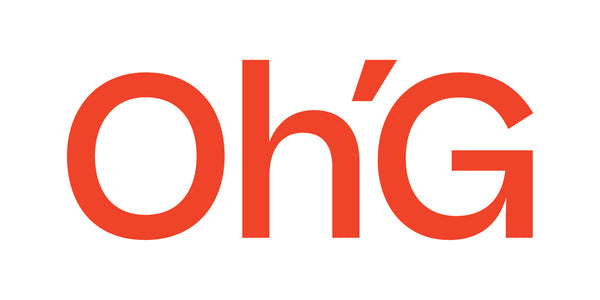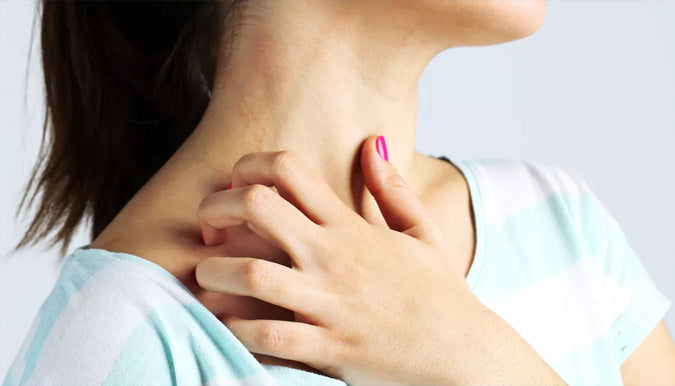Itching, burning, scaly flaky dry skin. Atopic eczema is a problem for roughly two to ten percent of adults and up to twenty percent of children, with most presenting within the first five years of life.
What is eczema?
There are seven different types of eczema, but most commonly people, and especially children, suffer from Atopic eczema (AE). Common symptoms of AE include red, inflamed skin and itching. There may be raised bumps, lesions and scaling (where sections of the skin shear off). One of the most characteristic symptoms is itching, which occurs in 100% of cases involving AE. It's said that if it doesn't itch then it's more likely to be contact dermatitis or another form of eczema.

What causes it?
AE is primarily caused by a breakdown of the skin barrier. Our skin barrier protects us from bacteria, allergens and irritants getting in and stops moisture getting out. People with eczema, for various reasons, have a weakness in the skin barrier. This may in part be hereditary or due to inflammation from external factors. Changes in season (especially cold weather), long hot showers, irritants (such as soap, washing powder or synthetic fabrics), food allergies, dust and other environmental irritants, stress, emotional disturbance and hormonal shifts can all play a part in the development of a dry skin problem and a breakdown of the protective barrier.
For children, a significant trigger for outbreaks can be dietary. You may have noticed that cutting back on a particular type of food or avoiding particular food groups made a difference to your breastfed baby's eczema, and in an older child this may manifest when they begin solids. Commonly dairy, eggs, nuts, wheat, seafood and soy are culprits. You can try taking suspect foods out of the diet then reintroducing them to see if the eczema responds to these changes.
Daily bathing
Keeping the skin clean is important, and a regular skin management routine is important to keep the skin hydrated and manage outbreaks.
Avoid very hot water and harsh soaps, and opt instead for a gentle cleanser. A fragrance free soap with soothing natural oils and a high "superfat" content is a good option. Superfat refers to the amount of oil in the soap not converted to soap via the saponification process, and will help to protect the skin rather than strip all the oils away. Most hand soaps will contain around three to five percent, while dish or laundry soap typically has zero percent. Look for an unscented soap that includes a robust moisturising oil or butter, such as cocoa or shea butter with a superfat value of at least five to ten percent.
The "soak and seal" method is recommended for bathing. Bathe in warm water for at least five minutes, pat the skin dry so it remains slightly moist, and apply generous amounts of moisturiser within minutes of getting out. This helps seal the water into the skin and is the best way to avoid flareups due to dry skin. During flares, a topical treatment should be applied and gloves and / or bandages can be applied to help seal the moisture from the shower and the moisturiser.
Moisturiser
 Eczema prone skin is dry because it isn't good at maintaining its water content, not necessarily because it isn't oily enough. Look for fragrance free, low irritant ingredients as many synthetic ingredients can be irritating. Use of a good, hypoallergenic moisturiser is important, even when outbreaks are in remission to help protect the skin. Topical applications of balms and salves are usually only suitable when the outbreaks occur. Moisturising every day is non negotiable for those with the tendency to dryness, so knowing this can go a long way towards helping to maintain skin balance and prevent flares from happening in the first place.
Eczema prone skin is dry because it isn't good at maintaining its water content, not necessarily because it isn't oily enough. Look for fragrance free, low irritant ingredients as many synthetic ingredients can be irritating. Use of a good, hypoallergenic moisturiser is important, even when outbreaks are in remission to help protect the skin. Topical applications of balms and salves are usually only suitable when the outbreaks occur. Moisturising every day is non negotiable for those with the tendency to dryness, so knowing this can go a long way towards helping to maintain skin balance and prevent flares from happening in the first place.
Herbal remedies
Doctors may prescribe steroid creams to manage outbreaks, but if you prefer to take a natural route there are many various plant based solutions that can help eczema sufferers.
Kawakawa - native to NZ, the kawakawa plant has been used for centuries by Maori for treatment of everything from dental pain to digestive issues. Its antimicrobial and analgesic properties make it useful for treating infections, and it can reduce inflammation of various skin conditions eczema and rashes. Typically the leaves will be infused in oil and a salve or balm made from the oil.
Calendula - Commonly known as Marigold, Calendula has been used since ancient times and is known for its powerful healing and soothing properties. The ancient Egyptians believed it to have rejuvenating properties and the ancient Greeks used the colourful petals to decorate their meals. A salve or balm containing the infused oil can be prepared which, applied regularly during flares can help to soothe and heal the irritation.
Colloidal oats - Use in a bath for a soothing soak, or in a cream for gentle topical benefits. Oats have been shown to soothe irritation and help combat the itching associated with skin irritations.
Natural oils
Natural oils are a great place to start when searching for products, most containing antioxidant and anti-inflammatory properties. Here are a few (by all means not all) oils shown to help manage eczema symptoms you may like to keep a lookout for on the ingredients list.
Hemp oil - hemp oil contains cannabidiol (CBD), which has powerful anti-inflammatory properties. It is also high in linoleic acid, which is important in maintaining the skin's moisture barrier.
Shea butter - a dense and nutrient rich moisturiser, shea works to maintain condition and helps regenerate cells in the skin's layers. Rich in antioxidants, allergic reactions to shea are extremely rare making it a great low allergen option.
Jojoba oil - famous in the natural skincare world as the oil that most closely resembles the skins natural sebum, jojoba has been shown to help protect the skin barrier. It also possesses excellent anti-inflammatory, antioxidant and skin healing properties.
Coconut oil - rich in various fatty acids and its antimicrobial and antifungal properties help to combat any possible infection as a result of the skin barrier weakness.
The takeaway
Maintenance of the skin is the most important part of managing AE, as it is easier to prevent rather than heal a flareup, so establish and maintain a daily cleansing and moisturising ritual.
Regular moisturising is key, so find a good, fragrance free low-allergen option that suits you and use it daily. As with all skin products, you may have to shop around before you find your perfect match and what works for some won't for others.
Keep a lookout for products recommended for eczema which contain natural ingredients, healing properties and avoid harsh synthetic fragrances. There are lots of natural healing products available to help manage flare ups.

